Precision Transducer Engineering’s Phoenix Loudspeaker
|
|
| Ruthlessly Revealing…and I’m Loving it! |
|
May 2011 |
|
|
Running into the folks from Precision Transducer Engineering (PTE) at the 2010 consumer Electronics Show was totally serendipitous considering I had no clue as to who they were. Got to take my hat off to them because they used the perfect bait to lure me into their room: jazz trumpeter extraordinaire Freddie Hubbard’s Grammy Award-winning album First Light.
Allow me to digress: In 1971, the year First Light exploded to number one on the jazz airwaves, I was an 11 year-old snotty-nosed kid who already had a pretty impressive record collection, thanks in a large part to my older sister. My dad was an avid jazz lover with an impressive collection of his own. But I never listened to his LPs because (a), I wasn’t allowed to touch his ’62 Grundig console, and (b), Motown had won our hearts and my sister and I found jazz a bit too incomprehensible.
A couple of years later—I must have been 13 or 14—I found myself snooping around my dad’s collection while he was at work, and I pulled out First Light and gave it a listen – on his Grundig no less. And for the first time, not only did I understand the rich melody, but First Light ignited an intense love for jazz that still burns brightly today. This wasn’t your typical Bebop jazz of the ’60s, this was a sophisticated ’70s style of jazz typical of Creed Taylor’s now defunct CTI label (which constituted a virtual Who’s Who of jazz masters). Don Sebesky’s soaring arrangements synced perfectly behind Freddie’s playing and was unlike anything I had ever heard. Music was never the same after that experience. Freddy Hubbard became my jazz hero. I was honored to later become a friend and to have talked with Freddie over the years.
When I entered the Precision Transducer Engineering room the first thing I noticed was their analogue rig. This, more than anything, told me these guys were into music, and on a level rarely seen at CES shows, where the promotion of new products and technologies often seems the ruling passion. These guys were showing off their LP collection to such an extent that I felt they were a bunch of party heads just wanting to share some music. I took a seat between a pair of large loudspeakers and that’s when marketing man Mark Thoke and designer/partner Jim Rush introduced themselves as the men behind PTE.
The loudspeakers were named Statement, and that’s just what they did. The sound had an overall ease and grace that was reminiscent of my big Majestic loudspeakers from Sunny Lo. You normally do not excite a loudspeaker of this size and sheer girth before you excite room resonances. This was a monster of a loudspeaker (over 400 lbs, 60″ tall by 25.5″ deep and 24″ wide) with an active tri-amped, 3-way system. Sensitivity is a remarkable 107 dB thanks in part to the TAD 2001 high-frequency concentric driver (modified to PTE specs) and a Tannoy 15″ mid/bass driver. The woofer section has a 18″ Underhung driver isolated in a separate enclosure. Equalization and amplification are analogue throughout “…to achieve noise levels not available through digital alternatives,” says Rush.
I was very impressed by what I heard but the price tag was even more amazing—$45k for loudspeakers this good is a steal. I’ve seen loudspeakers at the same asking price but with only a fraction of the Statement’s abilities. However, we all know that having a 400 pound gorilla in your living room isn’t going to be everybody’s cup of tea, so a real-world alternative for apartment dwellers is PTE’s smaller and more affordable baby gorilla, the Phoenix active-powered loudspeaker.
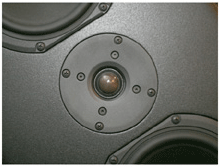 The Phoenix is a rear-ported, 2-way, self-powered, stand-mounted speaker with an active crossover network similar to its bigger brother. It’s 28″ tall by 12″ wide and 16.5″ deep: rather large as far as stand-mounted monitors go. It has dual 6.5″ Nomex mid/bass drivers sandwiching a single soft-domed Scanspeak dome tweeter in a classic D’Appolito configuration. A specially equalized active crossover network has a very flat response, and three 130-watt Class A/B amplifiers power each driver. Rush asserts “…the Phoenix can reproduce 31 Hz at over 113 dB with relative ease without any room reinforcements. Moreover, it will play your favorite music (40 Hz to 20 khZ) with remarkable dexterity at well over 116 dB with ease.”
The Phoenix is a rear-ported, 2-way, self-powered, stand-mounted speaker with an active crossover network similar to its bigger brother. It’s 28″ tall by 12″ wide and 16.5″ deep: rather large as far as stand-mounted monitors go. It has dual 6.5″ Nomex mid/bass drivers sandwiching a single soft-domed Scanspeak dome tweeter in a classic D’Appolito configuration. A specially equalized active crossover network has a very flat response, and three 130-watt Class A/B amplifiers power each driver. Rush asserts “…the Phoenix can reproduce 31 Hz at over 113 dB with relative ease without any room reinforcements. Moreover, it will play your favorite music (40 Hz to 20 khZ) with remarkable dexterity at well over 116 dB with ease.”

These specs are impressive, but what about its ability to realistically reproduce music?
With that in mind, I requested a pair be sent to my home. A couple of email correspondences later a pair of Phoenix loudspeakers were on their way. And about one week after that, two large corrugated boxes arrived at my front door compliments of UPS Inc.
One of the first things you notice when lifting the Phoenix is its weight, nearly 75 pounds each. The Phoenix feels rock solid and its 1″ MDF side-wall cabinets give it real substance. Dampening materials were used along with heavy-duty internal bracing to reduce cabinet ringing. The grills are held on magnetically which makes for very easy removal. I luckily had some old 22″ stands that had comfortably supported a pair of Talon Audio Fremont loudspeakers some years back.
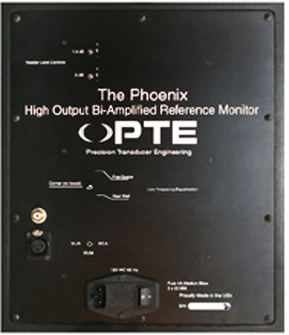
The rear of the Phoenix has tweeter/woofer level adjustments in 0.5 dB increments with a maximum of +/-2 dB. Another nice feature of the Phoenix is the option of RCA or XLR (balanced) connections. My first choice for longer runs is always XLR due to its superior connection and lower noise.
All in all, the Phoenix is an impressively built loudspeaker. Aesthetically speaking, it looks just like any other run-of-mill rectangular loudspeaker, which gives it a zero score on the personality scale. The standard wood finish is also ho-hum (I’m told there are other options). The Phoenix is certainly not a stunner in terms of looks but what about performance?
I doubt that in all my years of listening to loudspeakers I have heard any stand-mounted monitor reproduce music with such dynamic realism.
If you subscribe to the less-is-more school of thought, you’d expect a self-powered loudspeaker to sound ultra-transparent and truthful to the source—after all the amplifiers are just inches away from the drivers, obviating expensive loudspeaker cables. Admittedly, my experience with active monitors is limited. There are a certain few – ATC, ADAM and Meridian – that come to mind, that not only stand out as excellent choices, but excel at their respective craft (our own Carlos Sanchez has his own recording studio and uses a pair of ADAM self-powered monitors). I had a pair of ATC active monitors back in the early ’90s (can’t recall the model) and thought very highly of them. Lets face it, there’re very few active loudspeakers available on the high-end side of our industry. On the pro-audio side, active loudspeakers seem to have become a de facto standard among recording engineers. I think one reason active-loudspeakers have a tough time is because they take away the liberty of audiophiles to futz around with amplifiers and cables. There are, alas, few things that can quench our audiohiliac thirsts more than the mixing and matching of specially selected components.
But in the end, the issue of loudspeaker design still hinges on execution. There’s no guaranteed free lunch or better mouse trap with active loudspeakers. I’ve heard active-loudspeakers that sound terrible. I’ve heard passive loudspeakers that sound terrible. But, the PTE Phoenix is superb, regardless of category.
Performance
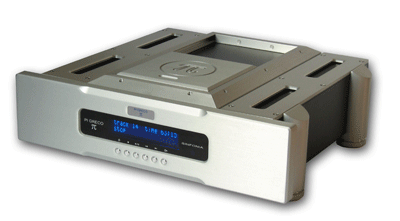 My setup included a pair of AC cords from Echole Cables of Turkey, the Pi Greco CD player (a beautiful Italian top-loader equipped with its own volume control – photo right) and a 1.5 meter run of Faber Audio cable (also Italian). With about 150 hours of burn-in logged at different volume levels and with the Phoenix rear switches set at neutral, I felt it was time to put it through its paces. Sitting in my dining room, remote in hand, it dawned on me how simple this setup was: self-powered speakers and an all-in-one CD player.
My setup included a pair of AC cords from Echole Cables of Turkey, the Pi Greco CD player (a beautiful Italian top-loader equipped with its own volume control – photo right) and a 1.5 meter run of Faber Audio cable (also Italian). With about 150 hours of burn-in logged at different volume levels and with the Phoenix rear switches set at neutral, I felt it was time to put it through its paces. Sitting in my dining room, remote in hand, it dawned on me how simple this setup was: self-powered speakers and an all-in-one CD player.  Nice. First song entitled Gone, from the CD “Urbanus” by vibraphonist Stefon Harris and Blackout (Concord Jazz). This up-tempo and funk-laced track immediately brought my attention to the Phoenix’s incredible weight, speed and deft at handling low-end information. I had never experienced a stand-mounted monitor, albeit a very large one, handle low-frequencies with no strain whatsoever. Cymbals were free of artifact and noise and sounded more interwoven in the music rather than floating above it. Not an easy feat for any loudspeaker, especially one retailing for about $5k. The Phoenix exhibits very low coloration and really gives life and three-dimensional space to voices and instruments. Soundstage extended across my dining room with a sense of focus and specificity—without any spot-lighting effect—and with minimum effort.
Nice. First song entitled Gone, from the CD “Urbanus” by vibraphonist Stefon Harris and Blackout (Concord Jazz). This up-tempo and funk-laced track immediately brought my attention to the Phoenix’s incredible weight, speed and deft at handling low-end information. I had never experienced a stand-mounted monitor, albeit a very large one, handle low-frequencies with no strain whatsoever. Cymbals were free of artifact and noise and sounded more interwoven in the music rather than floating above it. Not an easy feat for any loudspeaker, especially one retailing for about $5k. The Phoenix exhibits very low coloration and really gives life and three-dimensional space to voices and instruments. Soundstage extended across my dining room with a sense of focus and specificity—without any spot-lighting effect—and with minimum effort.
 One of the great voices in music today is Ethiopian beauty Sade Adu, and she doesn’t disappoint onMorning Bird, a catchy, but melancholy ballad from her latest CD, Soldier of Love. This song features a most powerful bass drum kick throughout its hauntingly catchy phrases that suggests who the engineers had in mind when they mastered this particular track: iPod users on the go. Though heavy handed and hyped, I wouldn’t characterize this “kick” as overly exaggerated. Indeed, this cut is now included in my show sampler CDs and serves as a perfect demo tool for low-end authority. Sade’s rasp and velvety voice against this hyped “kick” tells plenty about a sound system. The Phoenix demonstrated an articulate sense of weight, control and dynamic scale that I thought was reserved only for the big boys. At the same time, Sade’s voice remained very focused and centered, in front of this “kick,” and without losing its trademark velvety tone. I’ve heard systems push this “kick” forward and change focus to the drummer rather than the voice. Not so with the Phoenix. It’s power and grace allow the music to come through in a raw and unfiltered way.
One of the great voices in music today is Ethiopian beauty Sade Adu, and she doesn’t disappoint onMorning Bird, a catchy, but melancholy ballad from her latest CD, Soldier of Love. This song features a most powerful bass drum kick throughout its hauntingly catchy phrases that suggests who the engineers had in mind when they mastered this particular track: iPod users on the go. Though heavy handed and hyped, I wouldn’t characterize this “kick” as overly exaggerated. Indeed, this cut is now included in my show sampler CDs and serves as a perfect demo tool for low-end authority. Sade’s rasp and velvety voice against this hyped “kick” tells plenty about a sound system. The Phoenix demonstrated an articulate sense of weight, control and dynamic scale that I thought was reserved only for the big boys. At the same time, Sade’s voice remained very focused and centered, in front of this “kick,” and without losing its trademark velvety tone. I’ve heard systems push this “kick” forward and change focus to the drummer rather than the voice. Not so with the Phoenix. It’s power and grace allow the music to come through in a raw and unfiltered way.
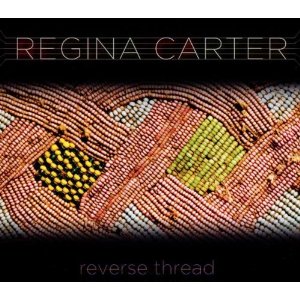 The innate sense of power and control coming from this loudspeaker was demonstrated over and over again, no matter the type of music chosen. Another great example of the Phoenix’s grip and control is the enchanting Kothbirofrom preeminent jazz violinist Regina Carter’s latest CD Reverse Thread. Kothbiro features an intro by master Kora player Yacouba Sissoko which later leads into Carter’s beautiful play on this enchanting piece (originally penned by Ayub Ogada). It is wonderful to hear both these delicate string instruments playing side by side—in perfect unison and balance—against a hypnotic melody that is neither intrusive nor highlighted. With the Phoenix, I get the sensation the instruments are just floating in a huge vacuum of deep space, a quality usually reserved for big rigs. This CD features Stereo Times’ very own Alvester Garnett on drums and I feel very fortunate to have heard this disc during its spirited mastering phase (that took place over a period of many months—once in my home). Unfortunately, I did not have the Phoenix here at that time but am so glad that I did get a chance to hear the “before and after.” This disc is an excellent example of what can happen when you’ve got an audiophile/musician lending a helping hand in the finalizing of a major jazz project. With a great sense of spectral ease, the phoenix demonstrated the virtues of this recording and, once again, the rare opportunity to hear a stand-mounted active-monitor play like a 500 pound gorilla. Whenever audio friends and or family came over to visit, they marveled at the sheer sense of scale the Phoenix conveyed even at low to moderate listening levels.
The innate sense of power and control coming from this loudspeaker was demonstrated over and over again, no matter the type of music chosen. Another great example of the Phoenix’s grip and control is the enchanting Kothbirofrom preeminent jazz violinist Regina Carter’s latest CD Reverse Thread. Kothbiro features an intro by master Kora player Yacouba Sissoko which later leads into Carter’s beautiful play on this enchanting piece (originally penned by Ayub Ogada). It is wonderful to hear both these delicate string instruments playing side by side—in perfect unison and balance—against a hypnotic melody that is neither intrusive nor highlighted. With the Phoenix, I get the sensation the instruments are just floating in a huge vacuum of deep space, a quality usually reserved for big rigs. This CD features Stereo Times’ very own Alvester Garnett on drums and I feel very fortunate to have heard this disc during its spirited mastering phase (that took place over a period of many months—once in my home). Unfortunately, I did not have the Phoenix here at that time but am so glad that I did get a chance to hear the “before and after.” This disc is an excellent example of what can happen when you’ve got an audiophile/musician lending a helping hand in the finalizing of a major jazz project. With a great sense of spectral ease, the phoenix demonstrated the virtues of this recording and, once again, the rare opportunity to hear a stand-mounted active-monitor play like a 500 pound gorilla. Whenever audio friends and or family came over to visit, they marveled at the sheer sense of scale the Phoenix conveyed even at low to moderate listening levels.
Absolute power corrupts absolutely
But make no mistake, the Phoenix isn’t a one pony act. While its strengths lie in its dynamic and bass output, it’s far more sophisticated than that. I admire how it gets the musical energy out into the room with an uncanny sense of balance, style and grace. Also, let’s not underestimate the importance of bass excellence coupled with accurate low end extension. I think it’s that special combination of power and grace that makes this active monitor so appealing. In a recent short discussion with PTE marketing man Mark Thoke, he explained “…the ultra flat frequency-response achieved by way of time-aligned active crossover and state-of-art amplifiers is what you’re hearing that allows us to do things that would be otherwise impossible in a speaker of this size.”
In my 17′ by 18′ dining room, I did not need to boost the low-end on the Phoenix with the rear panel switch. This slightly exaggerated the excellent bass integration that was already there in the “flat” position. In addition, I had the monitors only two feet from the front wall—they do not have to be all the way out in a room to work effectively. Once again, the Phoenix is a big monitor whose only drawbacks might lie in its aesthetics and the fact that its self-powered, restricting one’s freedom to switch amplifiers and speaker cables! Personally, I for one consider its self-powered status a huge plus when you consider the price/performance ratio. And yes, you too might agree once you hear how alive and dynamically engaging these loudspeakers are.
In the final analysis, the dynamic scale, buttery ease and razor sharp accuracy this powerful active transducer offers is, to my ears, nearly non-existent in anything near its size and asking price. If you’re a true fan of music rather than prestigious audio jewelry, you too might find the self-powered Phoenix loudspeaker as outstanding as I do.

![]()
clement perry
Specifications:
Input Impedance: RCA 5.09K, XLR 14K
Power: 90-120V 50-60 Hz
Input Sensitivity: .1Vrms for 100 dB SPL
Drivers two 6.5″ Nomex Woofers, One Duel Magnet 1″ silk dome tweeter
Amplifier specifications: Class AB 3 x 130W
BW 20-20Khz .1 dB, -3dB @ 250Khz
S/N ratio RE full output 114 dB A weighted
THD 20-20Khz < .04%
Damping Factor Re 8 Ohms 160
Price: $5400.00
Precision Transducer Engineering
Address: PO Box 6327
Orange, CA 92863
Phone: 714 722 4613
Fax: 714 997 2904
Website: http://pteacoustics.com
email: Info@PTEacoustics.com
![]()
Don’t forget to bookmark us! (CTRL-SHFT-D)
Stereo Times Masthead
Publisher/Founder
Clement Perry
Editor
Dave Thomas
Senior Editors
Frank Alles, Mike Girardi, Key Kim, Russell Lichter, Terry London, Moreno Mitchell, Paul Szabady, Bill Wells, Mike Wright, Stephen Yan, and Rob Dockery
Current Contributors
David Abramson, Tim Barrall, Dave Allison, Ron Cook, Lewis Dardick, Dan Secula, Don Shaulis, Greg Simmons, Eric Teh, Greg Voth, Richard Willie, Ed Van Winkle, and Rob Dockery
Music Reviewers:
Carlos Sanchez, John Jonczyk, John Sprung and Russell Lichter
Site Management Clement Perry
Ad Designer: Martin Perry


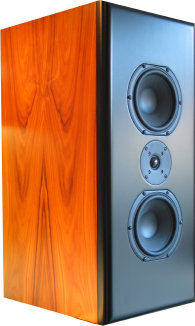



Be the first to comment on: Precision Transducer Engineering’s Phoenix Loudspeaker